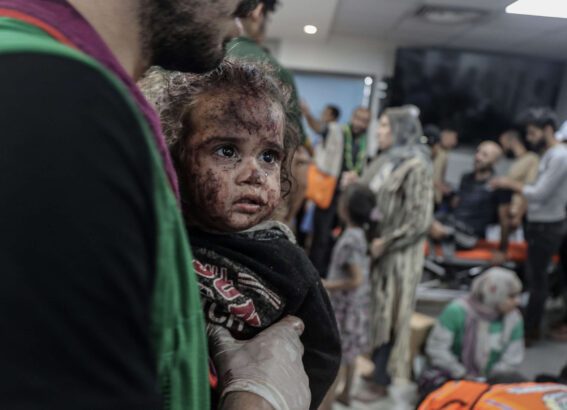In the midst of Israeli Airstrikes on Gaza that had killed over 3,000 people and injured over 12,000, a Gaza hospital experienced a blast that killed hundreds more…
By Alison Weir
On October 17th a blast at al-Ahli Baptist Hospital, a Christian-run medical complex in central Gaza City, killed at least 200 to 300 people and injured hundreds more.
The estimated death toll in Gaza at the time of the blast was already more than 3,000, with 12,500 injured. NBC reported that even before the blast, Gaza hospitals faced “a ‘tsunami of wounded’ as supplies and power ran out.” This was on top of a 16-year suffocating siege on Gaza (which had already experienced intermittent devastating blockades since at least 2002). The Israeli death toll is 1,400, with 4,000 injured.
Israel, at first tacitly admitted responsibility for hitting the hospital in its ongoing airstrikes against Gaza, but then switched direction and claimed that Palestinian “friendly fire” was responsible. Israeli officials have presented what they say is evidence showing that the massive damage was caused by misfired Palestinian rocketry. Israel has changed its version a number of times.
Many Palestinian officials and other observers have disputed the Israeli assertion, especially given that Israel had previously warned that Gaza hospitals would be damaged by its forces.
In fact, Israel had already bombed the hospital a few days earlier, on Saturday, October 14. Two upper floors of the centre were severely damaged and four hospital staff injured.*
Al Jazeera reports that a senior health official in Gaza says that Israel had fired two artillery shells as a “warning” at Al-Ahli Hospital two days before the recent blast.
According to the report, the hospital was first attacked on Saturday evening. A day later, the Israeli army called the hospital’s director and told him, “We warned you yesterday with two shells” and asked for the evacuation of the facility. The next day the attack on Al-Ahli occurred.
The New York Times reports a similar scenario.
The head of the Episcopal Church in Jerusalem and the Middle East, which runs the hospital, said that the Israeli military had called and texted the hospital managers at least three times since Saturday, asking its patients and staff to leave the hospital compound. The Archbishop said the warnings were particular to the hospital. The doctors told reporters at that time that they would not leave, because they had nowhere to take their patients, calling any evacuation a death sentence for patients who required electricity and oxygen.
Other evidence In the Times report also supports the contention that Israel was responsible for the attack:
Video posted after the Saturday attack — and verified by The New York Times — showed damage inside the hospital. The footage also showed the remnants of an artillery shell amid the debris.
Palestinian armed groups have typically relied on long-range artillery rockets to strike inside Israel and have not been recording using howitzers that fire shells of this type. But Israel commonly uses howitzers to strike inside Palestinian areas.
Israeli forces had also hit other Gaza hospitals in previous days, including Al-Dura hospital and the Indonesian hospital. (see this)
The World Health Organization (WHO) reported that there had been over 51 attacks on healthcare facilities in Gaza since the start of the conflict on October 7. Fifteen healthcare workers had been killed and 27 injured.
In addition, shortly after the Al-Ahli blast, Israeli airstrikes hit the European Hospital in Gaza. In other words, Israel clearly has a record of striking hospitals.
Some point out that Israel has a record of blaming Palestinians for attacks and then when the facts come out, sometimes publicly admitting that Israeli forces were responsible. For example, Israel at first claimed that Palestinians were responsible for the death of a Palestinian American journalist, only later to admit she was killed by Israeli fire.
Friendly Fire?
On the other hand, both BBC and the New York Times report evidence that seems to support the Israeli position that the Al-Ahli blast was the result of friendly fire: rockets misfired by a Palestinian resistance group (although the Times says the investigation is still preliminary).
Similarly, President Biden has repeated the Israeli version, saying that U.S. intelligence supports Israel’s contention that the blast was caused by a misfired Gazan rocket.
Since friendly fire is often a part of extended conflicts, the possibility of such causation is always worth considering. In the 2009 Israel-Hamas conflict, for example, it turned out that 45% of Israeli deaths were from Israeli friendly fire.
Given the present circumstances in Gaza – nightly bombing, entire neighborhoods reduced to rubble – it is possible that the facts will never be entirely certain to everyone’s satisfaction.
Israeli Attacks on Medical Facilities and Personnel
What is known at this point, however, is that Israeli forces have a long, documented record of damaging hospitals and healthcare facilities, and of killing and injuring Palestinian doctors, medics, and other medical workers, and targeting ambulances.
For example, during the 2014 conflict alone, Israeli forces reportedly damaged or destroyed 67 Gazan health care facilities and killed 16 health care workers.
Below are just a few of the many incidents from the past few years alone:
- On July 25, 2023 Israeli troops shot a medic with the Palestine Red Crescent Society “with two bullets in both feet” while he was on duty in Askar camp near Nablus.
- The Palestinian Red Crescent Society reports that in 2022 there were 14 direct attacks on PRCS staff and volunteers.
- In 2023, A Canadian doctor said that Israeli soldiers shot him in both legs as he was treating injured protesters in Gaza. During that period Israeli forces had injured 17 medics and killed one.
- In May 2022 Israeli forces damaged or destroyed 19 medical centers.
- In May 2021 Israel bombed a clinic operated by Doctors Without Borders.
- In 2021 Israeli forces killed doctors Ayman Abu al-Ouf and Muin al-Aloul.
- Paramedic Razan al-Najjar was killed by an Israeli sniper in 2018. A New York Times investigation found that the bullet that killed her ”was fired by an Israeli sniper into a crowd that included white-coated medics in plain view.”
These are just a few of the multitude of instances in which Israeli forces have caused injury and sometimes death to medical personnel.
American military personnel targeted
Another example is Israel’s 1967 attack on the USS Liberty, in which surviving U.S. crew members describe Israeli soldiers machine-gunning stretcher bearers.
Israel and its partisans also deny this, despite the findings of an American Commission headed by a four-star Admiral that conducted an independent investigation into the attack.
*Anglican News reports that “the strike on al-Ahli Arab hospital happened at 7.30 pm EST (4.30 pm GMT) on Saturday 14 October. Four hospital staff were injured in the blast and are receiving treatment for their wounds.” The hospital is run by the Anglican church.
The Anglican Archbishop of Jerusalem said that the area damaged by the Israeli strike, the Diagnostic Centre,
“is the Crown Jewel of Ahli Hospital, providing cancer diagnosis as a prelude to various treatment options both at Ahli and in other facilities. Next month, we were due to open a new chemotherapy centre there in partnership with Augusta Victoria Hospital on the Mount of Olives – a principal reason for our visit to the hospital last week.”
The Archbishop of Canterbury, Justin Welby, stated:
Hospitals and patients in Gaza are in grave danger. The seriously ill and injured patients at the Anglican-run Ahli Hospital – and other healthcare facilities in northern Gaza – cannot be safely evacuated. They are running low on medical supplies. They are facing catastrophe.
The Ahli Hospital was hit by Israeli rocket fire last night, with four staff injured in the blast. Other hospitals have also been hit.
I appeal for the evacuation order on hospitals in northern Gaza to be reversed – and for health facilities, health workers, patients and civilians to be protected.
The Israeli strike on Al Ahli Hospital days BEFORE the famous blast
Alison Weir is executive director of If Americans Knew, president of the Council for the National Interest, and author of Against Our Better Judgment: The Hidden History of How the U.S. Was Used to Create Israel. The article has been updated with additional information on the first strike on the hospital.
RELATED:
- Gaza-Israel: Latest news and statistics (ongoing updates)
- Israel’s Culture of Deceit
- Israel’s spin about hospital massacre quickly comes apart
- Palestinian-American child killed in Illinois: this is what media reports left out
- Gideon Levy: Israel Can’t Imprison Two Million Gazans Without Paying a Cruel Price
- Israelis went through what Palestinians have experienced for decades
- In Gaza, she now inhabits a solitary space between life and death





